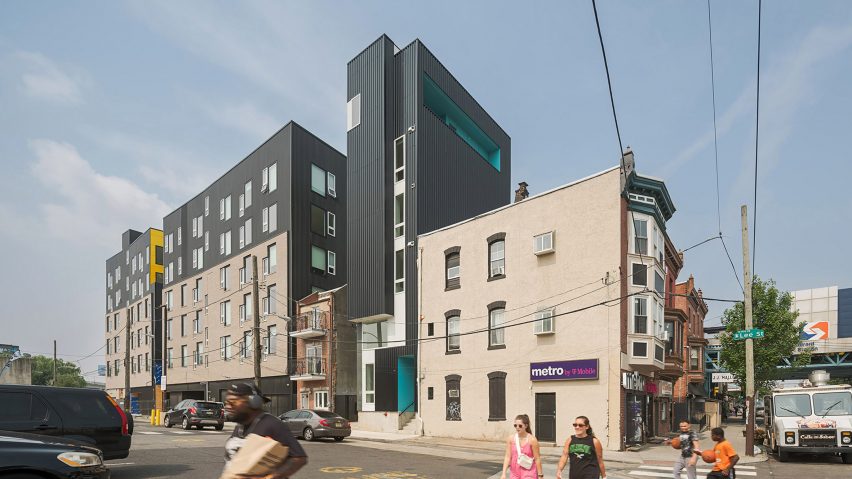American studio ISA has used a range of strategies to maximise space, light and views in the metal-clad Signal House, which rises from a slender urban lot.
The multi-level apartment building is located in Philadelphia's Fishtown neighbourhood, a transitioning area that has been attracting creative types and urban professionals.
Local firm ISA, or Interface Studio Architects, designed the Signal House to respond to its context, described as "a boisterous mix of elevated rail infrastructure, industrial buildings, late-night bars and restaurants, and busy arterial streets".
"Situated in this visually and sonically loud context, Signal House forms a camouflaged beacon, assertively addressing its surroundings," the studio said.
Built to accommodate singles, couples or families, the 3,500-square-foot (325 square metre) building occupies a site that typically would hold a single-family rowhouse. The site is 32 feet deep (9.8 metres) and just under 26 feet wide (eight metres).
The building's design is meant to "simultaneously draw attention from passersby and provide privacy to residents", the team said.
Rising 70 feet high (21 metres), the building appears as a slender, broken-up box with setbacks and extrusions.
Exterior walls are clad in black corrugated metal and fibre cement. Terraces and entry areas are painted turquoise, a nod to the nearby elevated rail line, which also is blue.
Along the street elevation, the team incorporated a tall volume that projects outward.
While envisioned as a reinterpretation of a bay window, the volume's face is mostly opaque for privacy reasons, as the building looks upon a fast food restaurant with a drive-through.
To provide more appealing views, windows were strategically placed in other areas of the building.
"The traditional bay window is reinterpreted as a streetwall buffer, with openings pushed from front to side and stacked within multi-storey slots along inner corners, editing views and washing interiors with daylight," the team said.
Within the building, one finds three rental units and a shared stairwell. Interior surfaces include luxury vinyl tile (LVT) flooring and white-painted walls.
Each apartment has two levels, connected by an internal staircase, with varied layouts that were derived from the building's "puzzle-shaped plan geometry".
"An interlocking organization incorporates mezzanine levels and bi-level unit layouts, going vertical as a way to add livable area, light and views on an otherwise landlocked little parcel," the team said.
The bottom apartment, which totals 705 square feet (65 square metres), holds two bedrooms, two bathrooms, a double-height communal area, and a mezzanine that can serve as an office or third bedroom.
The 554-square-foot (51-square-metre) middle unit contains one bedroom, one bathroom, a communal area and a mezzanine space similar to the unit below.
Measuring 722 square feet (67 square metres), the top apartment has two levels and features two bedrooms, two bathrooms, a communal area and a study. An inset balcony offers sweeping views of the area.
The layouts "allow residents to share common space and infrastructure while maintaining privacy, making for an efficient and replicable model for high-density urban housing".
ISA designed another narrow residential building in Philadelphia – the XS House, which has six units contained within a building that is 11 feet wide (3.3 metres).
Other projects by th studio include a white-coloured townhouse with interior spaces organised around a central core made of a birch plywood.
The photography is by Sam Oberter Photography.
Project credits:
Design team: ISA (Interface Studio Architects)
Client: Callahan Ward
Team: Brian Phillips, Deb Katz, Jason Jackson, Sarah Wolf, Emily Johnson

